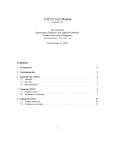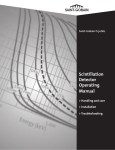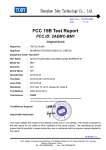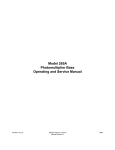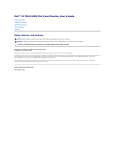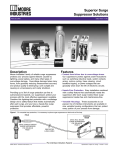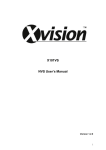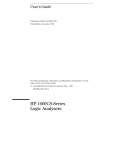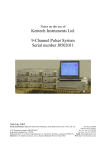Download Agilent 53310A Modulation Domain Analyzer
Transcript
Agilent 53310A Modulation Domain Analyzer Dynamic Frequency and Jitter Analysis at the Touch of a Button The Easy Way to Analyze Modulation and Jitter Autoscale Saves time by automatically selecting setup parameters to display your signals at the touch of a button. Fast update rate Fast update rate provides immediate visual results as changes occur in your signal or measurement setup. Jitter and modulation analysis Complete, automated analysis to characterize the modulation or jitter on any signal at the touch of a button. Hardcopy Output measurement data and instrument state can be sent to any GPIB graphics printer for archiving. 2 Frequency trigger Measurements are simplified with advanced triggering capabilities, allowing you to trigger on frequency or time interval measurements. Softkey-driven menu structure Intuitive, scope-like user interface allows you to quickly move from measurements to answers. Portability Compact size and light weight make the Agilent Technologies 53310A Modulaltion Domain Analyzer ideal for moving from workbench to workbench, or city to city. Programmability Full GPIB programmability, through the implementation of Standard Commands for Programmable Instruments (SCPI) saves time and makes automatic testing easier. New Capabilities Simplify Analysis of Complex Signals Many of today’s measurement techniques simply don’t provide adequate information to make demanding design decisions. Those that do are often cumbersome, difficult to use, or expensive. Not so with Agilent’s 53310A Modulation Domain Analyzer—providing a view of frequency or timeinterval measurements over time. This new way of seeing data is intuitive, allowing you to view your jitter or modulation directly. In much the same way the oscilloscope provides insight into the dynamics of changing voltage, the 53310A provides insight into changes in frequency or time-interval measurements. Setting up the analyzer is easy. Autoscale provides a one-button solution. At the press of a button your signal is analyzed and the proper instrument settings are selected. Unique triggering capabilities allow you to trigger directly on your modulation or periodic jitter. Characterization of modulation and jitter is easier with built-in analysis. Parameters like peak-to-peak deviation, carrier frequency, and modulation rate are all easily and automatically displayed. Jitter analysis is simplified with automated analysis of mean, standard deviation, and probability. The Modulation Domain is the missing piece of the puzzle. The oscilloscope shows you amplitude (voltage) versus time in the Time Domain. The spectrum analyzer shows you amplitude versus frequency in the Frequency Domain. And now, the Modulation Domain analyzer shows you frequency or time-interval measurements versus time in the Modulation Domain. The whole picture helps you improve your designs and bring them in on schedule. The Agilent 53310A provides all this and more, at a price you can afford. Shorten your design cycles through improved signal analysis A wide range of applications benefit from Modulation Domain analysis. New ways to view and analyze problems lead to streamlined solutions, saving you time in characterization and redesign. Jitter characterization of digital communications systems, disk and tape drives, and mechanical systems improves dramatically. The Modulation Domain makes it simple to study frequency drift in a range of electronic equipment, from lasers to oscillators. You can easily characterize the frequency-hopping performance of an agile transmitter, or measure a cellular phone switching from cell to cell. Discover a new way to analyze your signals and solve tough design challenges—a new perspective that helps you solve elusive problems and fine-tune your product performance. With the 53310A, you can sharpen your competitive edge. F V T 3 Understand Frequency Dynamics with Ease Modulation Domain analysis does for frequency what an oscilloscope does for voltage. The digitizing oscilloscope adds the time dimension to voltmeter readings, giving you a picture of the voltage variations over time. Changes in voltage are easily captured and analyzed. Measurements like V p-p, overshoot, and undershoot are simplified since voltage can be displayed as a function of time. This same simplicity is available now for frequency measurements. The 53310A adds the time dimension to frequency counter results. Now you can view frequency variations directly. Traditionally difficult measurements on modulated carriers are now simple. In effect, the 53310A becomes a “frequency oscilloscope”—measuring carrier frequencies up to 2.5 GHz as fast as every 1 µs. Through continuous sampling of the carrier frequency, modulation can be recovered and carrier dynamics analyzed. Much like an oscilloscope can trigger on a rising or falling voltage through a specified voltage threshold, the 53310A has the unique capability to trigger on a rising or falling frequency transition. Timing generators or sync signals are no longer necessary to trigger your measurement. This ability to trigger on frequency transitions greatly simplifies the analysis of VCOs, PLLs, and servo systems. View frequency modulation directly More than simply plotting individual measurement results over time, the 53310A Modulation Domain Analyzer makes frequency measurements continuously. Without the dead-time between measurements traditionally found in frequency counters or time-interval analyzers, this proves to be a better way to analyze your signals. This measurement technique not only maintains the relationship between measurements, it also ensures no loss of measurement information between samples. All of this is done with a single capture, thus eliminating the need for cumbersome, time-consuming profiling methods common with today’s frequency counters. Single touch measurements Measurements like peak-to-peak deviation, carrier frequency, and modulation rate are made easily with the touch of a button. Portions of the modulated carrier can be singled out quickly for detailed analysis. 4 Frequency changes and timing are fundamental characteristics of music. Similarly, these attributes are critical in many electronic systems and can easily be analyzed in the Modulation Domain. Imagine the time you can save with the 53310A by characterizing your designs directly and easily. Whether you are measuring a modulated signal or agile carrier, now your design decisions can be based on knowledge. You will no longer have to infer performance based on indirect measurement techniques that are commonly error prone and difficult to calibrate. New views of frequency stability With performance requirements increasing, better designs must be delivered faster and at a lower cost than ever before. As the error budgets of these designs shrink, the need for stability increases. Frequency vs Time Display The frequency modulation on this carrier is viewed and analyzed easily in the Modulation Domain. Whether it’s a simple design requiring a stable microprocessor clock, or sophisticated electronics controlling expensive equipment, quick access to new insight is required. Aggregate measures of jitter offered by conventional test techniques are often inadequate. They provide a convenient measure but allow little insight into the solution. As with deliberately modulated carrier frequencies, analysis of “stability” is done easily in the Modulation Domain. No longer limited to the magnitude of the jitter, the Agilent 53310A allows you to analyze the instability—breaking it into its periodic and random components. Fast Histogram of Frequency Fast histogramming makes statistical characterization easy. 5 A Complete Picture of Timing Jitter on Digital Signals Identify sources of instability with certainty When coupling to a power line, switching power supply and high speed digital circuitry are common causes of instability. However, determining the actual cause of the problem can be a tedious, time-consuming process with traditional techniques. The 53310A makes this process simple. With the use of powerful pushbutton analysis functions, the periodic element can be analyzed and the source of the problem identified with certainty. Timing and duration of the instability can be captured easily to give you valuable insight in resolving your problem. Switching transients, and other temporary causes of instability, are identified easily and quickly once the timing is known. The 53310A allows you to focus the bulk of your time on the design solution, rather than identifying the source of the problem. The 53310A provides you with new techniques to enhance your understanding of: • • • • • • jitter on a serial data stream timing between optical encoder pulses timing relationships of clock-to-data jitter propagation delay through an electronic device variations in pulse parameters results of a new pulse width encoding scheme. Easily capture and analyze serial data timing Analysis of serial data timing is crucial for refining designs on a variety of circuits, from the simplest IC, to a clock recovery circuit, to complete systems. Data storage devices such as magnetic disk drives, tape drives, and compact disks rely on precise timing to increase capacity and reduce data error. Electromechanical systems, used extensively from consumer products to sophisticated robotics, require precise timing analysis for optimizing servo designs. Timing jitter is commonly characterized indirectly with an oscilloscope. By looking at the “fuzz” on the oscilloscope trace, you can make assumptions about the jitter. All too often this is simply inadequate and a more complete view is required. The Modulation Domain gives you a better way to study jitter. Through insightful “vs Time” and histogram displays, the Agilent 53310A Modulation Domain Analyzer presents a detailed picture of jitter. The jitter’s variation over time and its statistical behavior are simple to characterize. No longer are you limited to the peak-to-peak jitter measurement made by the oscilloscope. Random and periodic elements of jitter are available at a glance from the “vs Time” display, providing valuable information. Automated analysis functions make quantifying jitter as simple as pushing a button. The Histogram display gives you an unsurpassed level of confidence about the statistical behavior of jitter, allowing you to make necessary design tradeoffs. 6 The power line’s effect on this oscillator is clearly identified. Serial data analysis is often difficult, pushing conventional measurement techniques to their limits. Often the need to analyze thousands or millions of pulses while maintaining precise timing is unmet. The 53310A significantly reduces the effort required to collect and analyze this type of data. With the “vs Time” display, timing between thousands of pulses can be captured and displayed as they occur in time, each measured with subnanosecond precision. Convenient markers and automated analysis functions allow detailed timing analysis of all or part of the captured information. Triggering on data dropouts is simple, using the time-interval triggering capability of the 53310A. For large amounts of data, the 53310A’s fast histogram feature allows millions of timing measurements to be captured in seconds. The statistical behavior of the timing is quickly and easily analyzed with the histogram display and automated analysis functions. In the case of multiple distributions, each distribution can be isolated and analyzed using markers. In the motion of a spinning top, small deviations are difficult to observe. The same is true when characterizing jitter in electronic systems. The Modulation Domain makes it easy to characterize jitter and identify its source. Fast Histogram of Time-Interval Statistical analysis of timing is simplified with built-in analysis functions. 7 Simplify data-to-clock jitter analysis Frequently the timing relationship between two signals is key in understanding a design’s performance. In the case of semiconductors or digital modules, propagation delay or skew can be a key design criterion. The 53310A’s ability to characterize this jitter easily and directly provides you with fast results and greater understanding. Your ability to view the timing relationships of multiple signals as they change over time gives you valuable information during design and prototyping phases, and beyond. The Modulation Domain reveals important information about potential sources of jitter, such as interference from a power supply or nearby digital circuitry. Time-Interval vs Time Display The periodic and random elements of this data-to-clock jitter provide valuable insight. 8 View pulse width modulation directly Many of today’s encoding schemes used on tape drives and compact disks employ pulse width modulation. Many other products, like antilock brake systems and servo control of motors, use pulse width modulation to maintain control. In all of these cases, the 53310A is a valuable tool for characterizing and understanding your design. This form of modulation creates new challenges in measurement and characterization. Not only is it necessary to measure the width of each pulse, but the timing relationship between pulses is essential for complete characterization. With the 53310A, thousands of pulses can be captured and easily analyzed using the Time-Interval vs Time display. Measurement markers and built-in analysis functions simplify characterization and analysis. Histogram displays give you further insight, allowing you to look at the distribution of a particular pulse width. Fast Histogram of Pulse Width Each distribution of the pulse width modulation data can be individually analyzed. Simple Solutions to Tough Modulation and Jitter Analysis Autoscale captures your jitter and modulation At the touch of a button, the 53310A quickly determines threshold level and vertical and horizontal scale factors to display your signal. Ultra-fast update rate and intuitive user interface simplify analysis This powerful combination makes operation intuitive. Real-time display of measurement results, coupled with a user interface that is easy to navigate, makes instrument setup and data analysis simple. You will save time—allowing you to focus on design improvements rather than lengthy characterization. Frequency triggering eliminates complexity The unique ability of the 53310A to trigger on a rising or falling frequency or time interval streamlines information capture. From capturing VCO step responses to analyzing data dropouts, Value Triggering usually eliminates the need for external sync signals which are often expensive to produce or unavailable. Millions of measurements gathered in seconds Thorough characterization often requires large, statistically valid samples of frequency or timeinterval measurements. Without the proper equipment, this can be a laborious, time-consuming task. Fast Histogram allows you to capture millions of measurements at rates up to 2.5 million per second. Easy to maintain and repair Simplicity is carried throughout the design of the 53310A. Periodic calibrations can be done quickly, with no disassembly. Features like screen-saver mode and built-in diagnostics protect your investment. The analyzer’s high reliability ensures your measurement integrity and minimizes downtime. With an estimated Mean Time Between Failures (MTBF) of greater than 20,000 hours, you have a lower risk of product failure. Powerful diagnostics and modular design minimize repair time, should it become necessary. Fully automated analysis is available at the touch of a button Both jitter and modulation are easy to quantify and analyze with built-in analysis. Modulation rate, carrier frequency, and peak-to-peak deviation are easy to measure on all, or just a portion, of your measurement data. Statistical analysis of jitter is done with one-button functions for mean, standard deviation, and probability. At the touch of a button, Autoscale determines the instrument configuration to display and analyze your signal. 9 Select the Right Modulation Domain Instrument for Your Analysis Agilent Technologies offers a variety of Modulation Domain products to enhance your analysis of modulation and jitter. The 53310A Modulation Domain Analyzer and the E1725C Time Interval Analyzer are the general purpose instruments for Modulation Domain analysis. Agilent 53310A The simple, easy-to-use 53310A Modulation Domain Analyzer provides a basic feature set, measuring frequency and time interval. It provides unique capabilities in triggering, real-time display and memory depth . . . all at a low price. Feature Benefit 53310A Option 031 Option 305 Frequency Completely characterize frequency modulation and drift 10 Hz-200 MHz, Channel C (Optional): 50 MHz-2.5 GHz Channel C, 50 MHz-2.5 GHz Same as basic unit Time Interval Characterize jitter and timing with superior resolution Up to 1 second with 200 ps rms resolution Same as basic unit Some calculations required Continuous Sample Rate View fast transitions in your signal's modulation vs Time: 1-1.25 MHz Fast Histogram: 1.5-2.5 MHz Sample rates up to 8 MHz with repetitive signals Same as basic unit Maximum Measurement Memory View modulation or jitter over a longer time for a given sample rate 8 k, 32 k optional Same as basic unit Same as basic unit Measurement Functions Obtain results directly through a variety of measurements Frequency and Time Interval Same as basic unit Frequency, Frequency Deviation, Phase Deviation, Phase Power Spectral Density, FFT and Settling Time Arming and Gating Capture the specific portions of a complex input signal Frequency and Time Interval Trigger — Six arming combinations Adds an adjustable RF envelope trigger Same as basic unit Display Modes Gain a new perspective on signal performance with powerful displays vs Time, Histogram, and Fast Histogram Same as basic unit vs Time, Histogram, Fast Histogram, FFT, Phase Power Spectral Density 10 Option 031 Means Faster Time to Market for Your Digital RF Communications Designs Digital RF communications is a fast growing and changing field. Major programs are underway worldwide to develop and implement new digital cellular communications systems and advanced cordless telephones. As an RF designer you need new test and measurement equipment to meet the challenging time-to-market requirements of your industry. The Agilent 53310A Modulation Domain Analyzer’s Option 031, “Digital RF Communications Analysis/ High Resolution 2.5 GHz Input,” will allow you to bring your designs to market faster and with more confidence than ever before. Automatic measurements of synthesizer settling time, Frequency Shift Keyed (FSK) center frequency, and FSK peak deviation will save you valuable development time. Option 031’s improved frequency resolution for RF signals means you won’t waste time with complicated external downconversion to meet your resolution requirements. The option also provides increased sampling rate to measure fast data rate systems such as Digital European Cordless Telephone (DECT). Time referenced trigger Option 031 measurements can be referenced in time to an external trigger. For example, you can accurately reference your synthesizer settling time to the step command edge. Increased modulation bandwidth Sample rates of up to 8 MHz can be achieved for repetitive signals. This extends the modulation bandwidth to approximately 2 MHz to cover fast data rate systems such as DECT. External LO input An external local oscillator can be used to further enhance measurement resolution. A rear panel input is supplied. RF envelope trigger An adjustable RF envelope trigger simplifies measurement setup by automatically triggering on a detected TDMA burst. This also makes it easy to characterize turn-on and turn-off transients. The detected TDMA burst trigger is provided as a rear panel output. 53310A DUT Radio or Synthesizer RF Output Sync Trigger (optional) Direct connection eliminates the need for cumbersome external mixers, filters, discriminators, or detectors between your device under test and measurement instrumentation. 11 View Complex Modulation Directly High resolution RF measurements Many new digital RF communication systems employ complex modulation techniques such as Gaussian Minimum Shift Keying (GMSK). Fast, direct views of these narrow band modulations are needed to improve frequency and timing characterization and shorten design cycles. The 53310A’s Option 031 provides direct frequency versus time views of your complex modulations. The high resolution RF input allows you to profile narrow band modulations directly. This eliminates the need for external downconversion, saving you time and effort. Frequency vs Time Display The high resolution RF input directly profiles the 0.3 GMSK modulation on a GSM carrier. 12 Direct frequency versus time eye diagrams Frequency versus time eye diagrams provide a quick, qualitative view of transmitter performance. Eye diagrams allow you to view effects of bit jitter and inter-symbol interference (ISI) directly on the RF carrier. The frequency versus time eye diagram can be compared to a conventional baseband eye diagram on an oscilloscope. Comparing the RF eye diagram and the baseband eye diagram allows you to quickly isolate problems with the RF chain. This direct view eliminates the need to guess at RF performance. Frequency vs Time Display Frequency versus time eye diagrams make it easy to view jitter effects on the RF carrier. Simplify PLL/Synthesizer Characterization with Automatic Measurements Automatic settling time measurements Improving synthesizer performance is a key part of the design effort for today’s digital RF communication systems. Agilent 53310A Option 031 provides direct, automatic settling time measurements. You simply enter the target frequency and tolerance band, and the analyzer automatically calculates the settling time from its frequency versus time display. The synthesizer step command is typically used as a “time-zero” reference to trigger the analyzer. The measurement is made with resolution of better than 100 Hz for carrier frequencies up to 2.5 GHz. Frequency vs Time Display Settling time is displayed automatically on this direct measurement of the synthesizer step. Quick synthesizer pulling analysis Another consideration for synthesizer performance is frequency pulling due to amplitude variations. Pulling typically occurs when a Time Division Multiple Access (TDMA) burst is powered on. The power ramp can cause a temporary shift in the synthesizer’s output frequency. The 53310A makes it easy to see pulling effects on your synthesizer. The frequency versus time display provides a direct view of the pulling transient. You quickly see how far off in frequency the synthesizer is pulled and how long it takes to relock. Frequency vs Time Display Frequency pulling can occur when the amplitude is ramped up at the beginning of the TDMA time slot. Pulling effects can be seen easily. 13 Option 305 Offers Flexible Phase Analysis for Faster RF Communications Time to Market The 53310A Modulation Domain Analyzer’s Option 305 Phase Analysis Software adds the power of phase analysis in the Modulation Domain to your 53310A. Now you can better understand your design through direct phase analysis by measuring phase settling time, phase noise (phase spectrum), phase deviation, and phase trajectory. If you already own a 53310A, purchase the software separately as the 53305A Phase Analysis Software. The software runs on any IBM-compatible PC with MS Windows®. Simply connect your PC to the 53310A using IEEE 488.2. Enhance your Agilent 53310A with powerful phase analysis software that runs on your PC. 14 With the software, you can measure and display frequency, frequency deviation, and phase deviation. From these displays, you can analyze settling time characteristics, view histograms and statistics, and even perform an FFT to get phase noise and jitter spectrum. Modulation analysis Many new digital RF communication systems employ complex frequency and phase modulation techniques. The 53310A Option 305 provides direct frequency and phase versus time views of your complex modulation. The high resolution RF input (Option 031) lets you directly profile both wide and narrow band modulations up to a 500 kHz modulation rate. This eliminates the need for external downconversion, saving you time and effort. Gain a better understanding of your RF system performance with the phase modulation display (Pi/4 DQPSK shown). Phase noise Modulation rates, spurious modulation, and total integrated noise over the modulation bandwidth are uncovered easily with the Phase Power Spectral Density (phase noise) display. This display is simply a calibrated version of the FFT of a phase deviation display. Related Literature For more information, please refer to the Agilent 53310A Modulation Domain Analyzer Data Sheet and U.S. Price List. Uncovering spurs or measuring total integrated noise over the modulation bandwidth is a snap with the Phase Power Spectral Density display. 15 Agilent Technologies’ Test and Measurement Support, Services, and Assistance Agilent Technologies aims to maximize the value you receive, while minimizing your risk and problems. We strive to ensure that you get the test and measurement capabilities you paid for and obtain the support you need. Our extensive support resources and services can help you choose the right Agilent products for your applications and apply them successfully. Every instrument and system we sell has a global warranty. Support is available for at least five years beyond the production life of the product. Two concepts underlie Agilent’s overall support policy: “Our Promise” and “Your Advantage.” By internet, phone, or fax, get assistance with all your test and measurement needs. Our Promise “Our Promise” means your Agilent test and measurement equipment will meet its advertised performance and functionality. When you are choosing new equipment, we will help you with product information, including realistic performance specifications and practical recommendations from experienced test engineers. When you use Agilent equipment, we can verify that it works properly, help with product operation, and provide basic measurement assistance for the use of specified capabilities, at no extra cost upon request. Many self-help tools are available. Europe: (tel) (31 20) 547 2323 (fax) (31 20) 547 2390 Your Advantage “Your Advantage” means that Agilent offers a wide range of additional expert test and measurement services, which you can purchase according to your unique technical and business needs. Solve problems efficiently and gain a competitive edge by contracting with us for calibration, extra-cost upgrades, outof-warranty repairs, and on-site education and training, as well as design, system integration, project management, and other professional services. Experienced Agilent engineers and technicians worldwide can help you maximize your productivity, optimize the return on investment of your Agilent instruments and systems, and obtain dependable measurement accuracy for the life of those products. Windows® and MS Windows® are U.S. registered trademarks of Microsoft Corporation. Online Assistance www.agilent.com/find/assist Phone or Fax United States: (tel) 1 800 452 4844 Canada: (tel) 1 877 894 4414 (fax) (905) 206 4120 Japan: (tel) (81) 426 56 7832 (fax) (81) 426 56 7840 Latin America: (tel) (305) 269 7500 (fax) (305) 269 7599 Australia: (tel) 1 800 629 485 (fax) (61 3) 9272 0749 New Zealand: (tel) 0 800 738 378 (fax) (64 4) 495 8950 Asia Pacific: (tel) (852) 3197 7777 (fax) (852) 2506 9284 Product specifications and descriptions in this document subject to change without notice. Copyright © 1998, 2000 Agilent Technologies Printed in U.S.A. 7/00 5966-4093E
















